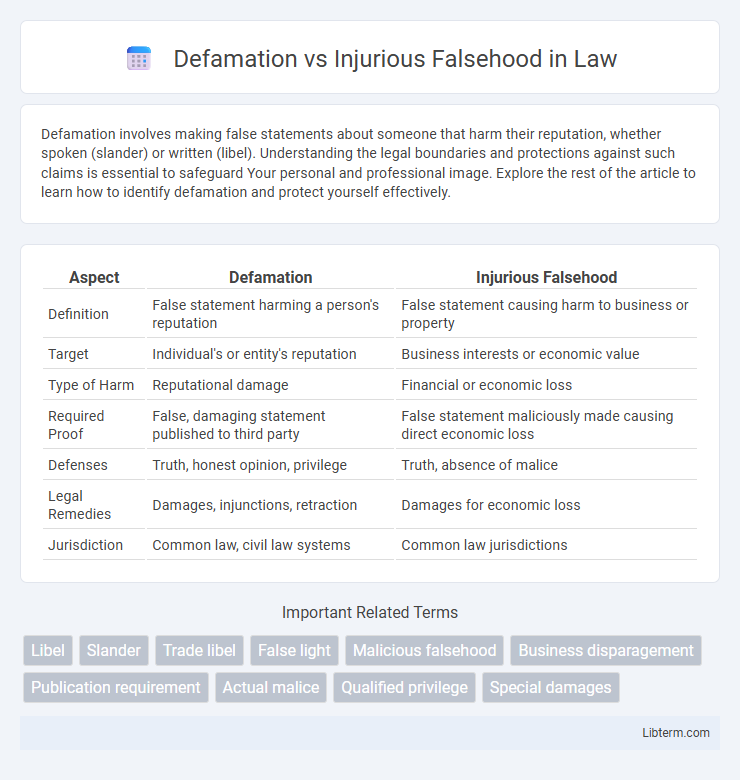Defamation involves making false statements about someone that harm their reputation, whether spoken (slander) or written (libel). Understanding the legal boundaries and protections against such claims is essential to safeguard Your personal and professional image. Explore the rest of the article to learn how to identify defamation and protect yourself effectively.
Table of Comparison
| Aspect | Defamation | Injurious Falsehood |
|---|---|---|
| Definition | False statement harming a person's reputation | False statement causing harm to business or property |
| Target | Individual's or entity's reputation | Business interests or economic value |
| Type of Harm | Reputational damage | Financial or economic loss |
| Required Proof | False, damaging statement published to third party | False statement maliciously made causing direct economic loss |
| Defenses | Truth, honest opinion, privilege | Truth, absence of malice |
| Legal Remedies | Damages, injunctions, retraction | Damages for economic loss |
| Jurisdiction | Common law, civil law systems | Common law jurisdictions |
Introduction to Defamation and Injurious Falsehood
Defamation involves making false statements that harm a person's reputation, whereas injurious falsehood pertains to false statements damaging a person's economic interests. Both legal concepts protect different facets of harm: defamation safeguards personal and professional character, while injurious falsehood targets business and property interests. Understanding these distinctions is crucial for addressing claims related to reputational and economic harm under the law.
Key Definitions: Defamation vs Injurious Falsehood
Defamation refers to the communication of false statements that harm an individual's reputation, causing damage to their personal or professional standing. Injurious falsehood involves the publication of false statements that specifically damage the economic interests or business reputation of a person or entity. Both torts require proof of falsity and damages, but defamation centers on personal injury while injurious falsehood targets commercial harm.
Legal Elements of Defamation
Defamation requires the plaintiff to prove that a false statement was made to a third party, causing harm to the plaintiff's reputation, and that the statement was unprivileged and made with at least a negligent level of fault. The legal elements include publication, falsity, identification, defamatory meaning, fault, and damages. Unlike injurious falsehood, defamation focuses primarily on injury to reputation rather than economic loss from false statements about property or business.
Legal Elements of Injurious Falsehood
Injurious falsehood requires the plaintiff to prove the publication of a false statement made maliciously with the intent to cause financial loss. Unlike defamation, which protects reputation, injurious falsehood specifically safeguards economic interests by demonstrating actual special damages resulting from the falsehood. Legal elements include falsity of the statement, malice, publication to a third party, and measurable pecuniary harm.
Major Differences Between Defamation and Injurious Falsehood
Defamation primarily concerns false statements that damage a person's reputation, while injurious falsehood involves false statements that harm a person's economic interests or property. Defamation requires proof of reputational harm and often hinges on whether the statement was published with negligence or malice, whereas injurious falsehood necessitates demonstrating actual economic loss caused by malicious false statements about goods or business. Legal remedies for defamation typically include damages for reputational injury, whereas injurious falsehood claims seek compensation for financial losses resulting from the harmful statements.
Burden of Proof in Each Claim
Defamation requires the claimant to prove that a false statement was made, published, and caused harm to their reputation, with the burden often on the defendant to show truth as a defense. Injurious falsehood demands the claimant establish the falsity of the statement, malice or intent to cause harm, and direct economic loss suffered due to the falsehood. In both claims, the burden of proof centers on demonstrating falsity and resultant damage, but injurious falsehood typically requires proof of malice and specific financial harm, differentiating it from defamation's broader reputational focus.
Defenses Available for Defamation and Injurious Falsehood
Defenses available for defamation typically include truth, honest opinion, absolute privilege, qualified privilege, and consent, each providing protection based on the context or nature of the statement. In contrast, defenses for injurious falsehood primarily involve proving the statement was made without malice, the truth of the statement, or that it was a fair comment on a matter of public interest. Both sets of defenses aim to balance protection of reputation with freedom of expression under tort law.
Remedies and Damages for Plaintiffs
Plaintiffs in defamation cases may seek remedies including general damages for harm to reputation, special damages for specific financial losses, and sometimes punitive damages to punish malicious conduct. In injurious falsehood claims, damages primarily cover actual economic loss resulting from false statements about goods, property, or business, with recovery focusing on quantifiable financial harm rather than personal reputation. Equitable remedies like injunctions are available in both torts to prevent ongoing or future harm caused by defamatory or false disparaging statements.
Notable Case Examples: Defamation and Injurious Falsehood
In defamation law, the landmark case New York Times Co. v. Sullivan (1964) established the "actual malice" standard for public figures, requiring proof that false statements were made knowingly or with reckless disregard for the truth. For injurious falsehood, the case of Besser Manufacturing Co. v. U.S. Metal Products Co. demonstrated how false statements causing economic harm can result in liability, emphasizing the need to prove malice and special damages. These cases underscore key distinctions where defamation protects reputation, while injurious falsehood safeguards economic interests from malicious false statements.
Conclusion: Choosing the Right Legal Action
Defamation protects reputation by addressing false statements that harm an individual's character, while injurious falsehood targets false claims causing economic loss to a business or property. Selecting the appropriate legal action depends on whether the primary damage is personal reputation or commercial interest, with defamation focusing on honor and injurious falsehood emphasizing financial harm. Understanding these distinctions ensures effective legal recourse and maximizes the likelihood of successful claims.
Defamation Infographic

 libterm.com
libterm.com